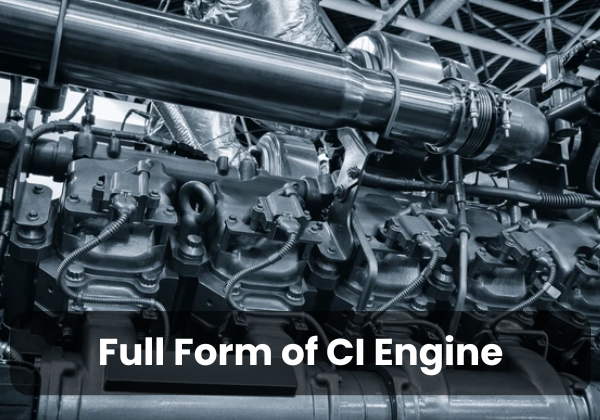The CI engine full form stands for Compression Ignition Engine, a type of internal combustion engine widely used in heavy-duty vehicles, industrial machinery, and power generators. Unlike spark-ignition (SI) engines, CI engines rely solely on high compression to ignite the fuel, making them more efficient for diesel-based applications.
This article explores the working principle, types, advantages, and applications of CI engines, along with key differences from petrol engines.
What is a CI Engine?
A Compression Ignition (CI) Engine is an internal combustion engine where fuel ignition occurs due to high-temperature compressed air, eliminating the need for a spark plug. These engines primarily use diesel fuel and are known for their high thermal efficiency and durability.
Key Characteristics of CI Engines
-
No spark plug (ignition via compression)
-
Higher compression ratio (16:1 to 22:1)
-
Used in trucks, ships, and heavy machinery
-
Better fuel efficiency than petrol engines
How Does a CI Engine Work?
The CI engine operates on the Diesel Cycle, which consists of four strokes:
1. Intake Stroke
2. Compression Stroke
3. Power Stroke (Combustion)
-
Diesel fuel is injected into the hot compressed air, causing auto-ignition.
-
The explosion forces the piston downward, generating power.
4. Exhaust Stroke
Note: Unlike petrol engines, CI engines do not use a throttle valve, relying instead on fuel injection control for power regulation.
Types of CI Engines
CI engines are classified based on design and operation:
1. Based on Stroke Cycle
| Type | Description | Applications |
|---|---|---|
| Four-Stroke CI Engine | Completes one cycle in four strokes | Trucks, Buses, Generators |
| Two-Stroke CI Engine | Completes one cycle in two strokes | Ships, Large Industrial Engines |
2. Based on Fuel Injection
| Type | Description |
|---|---|
| Direct Injection (DI) | Fuel injected directly into the combustion chamber |
| Indirect Injection (IDI) | Fuel injected into a pre-chamber before entering the main cylinder |
3. Based on Aspiration
| Type | Description |
|---|---|
| Naturally Aspirated | Air intake depends on atmospheric pressure |
| Turbocharged | Uses a turbocharger to force more air into the cylinder |
Advantages of CI Engines
-
Higher Fuel Efficiency – Diesel contains more energy per liter than petrol.
-
Greater Torque Output – Ideal for heavy-load applications.
-
Longer Engine Life – Robust construction with no spark plugs.
-
Lower CO₂ Emissions – Better mileage reduces carbon footprint.
Disadvantages of CI Engines
-
Higher Initial Cost – Complex fuel injection systems increase price.
-
Noisier Operation – Combustion at high pressure creates more noise.
-
Particulate Emissions – Produces more soot than petrol engines.
CI Engine vs. SI Engine: Key Differences
| Parameter | CI Engine | SI Engine |
|---|---|---|
| Full Form | Compression Ignition | Spark Ignition |
| Fuel Used | Diesel | Petrol/CNG |
| Ignition Method | High compression | Spark plug |
| Compression Ratio | 16:1 to 22:1 | 8:1 to 12:1 |
| Efficiency | Higher (up to 40%) | Lower (25–30%) |
| Applications | Trucks, Ships, Generators | Cars, Bikes, Small Vehicles |
Applications of CI Engines
-
Automobiles – Trucks, buses, and SUVs.
-
Marine Industry – Ship and submarine engines.
-
Agriculture – Tractors and irrigation pumps.
-
Power Generation – Diesel generators for backup electricity.
-
Industrial Machinery – Excavators and cranes.
Future of CI Engines
With increasing environmental regulations, CI engines are evolving with:
-
Advanced Emission Control (DPF, SCR systems)
-
Biofuel Compatibility (Biodiesel blends)
-
Hybrid Diesel-Electric Systems (Better fuel economy)
Conclusion
The CI engine full form (Compression Ignition Engine) represents a robust and fuel-efficient technology widely used in heavy-duty applications. Understanding its working principle, advantages, and differences from SI engines is crucial for mechanical engineering students and automotive enthusiasts.
For in-depth learning, explore Aakash Institute’s engineering courses, which cover advanced concepts in IC engines and automotive technology.
CI Engine (Compression Ignition Engine) FAQs
1. What is the full form of CI engine?
The full form of CI engine is Compression Ignition Engine, where fuel ignition occurs due to high compression of air rather than a spark plug.
2. What fuel is used in a CI engine?
CI engines primarily use diesel fuel, though some modified versions can also run on biodiesel or other alternative fuels.
3. Why does a CI engine not need a spark plug?
A CI engine relies on high compression (16:1 to 22:1 ratio) to heat the air inside the cylinder, causing auto-ignition when diesel fuel is injected.
4. What are the main applications of CI engines?
CI engines are widely used in heavy vehicles like trucks and buses, marine transport including ships, power generators, and agricultural machinery such as tractors and pumps.
5. How is a CI engine different from an SI engine?
The main difference is that CI engines use compression ignition (no spark plug) and run on diesel, while SI (Spark Ignition) engines use a spark plug and run on petrol or CNG. CI engines are more efficient but produce more noise and vibration compared to SI engines.

